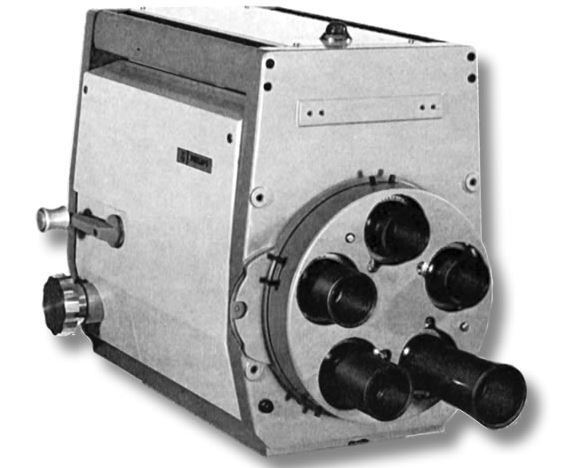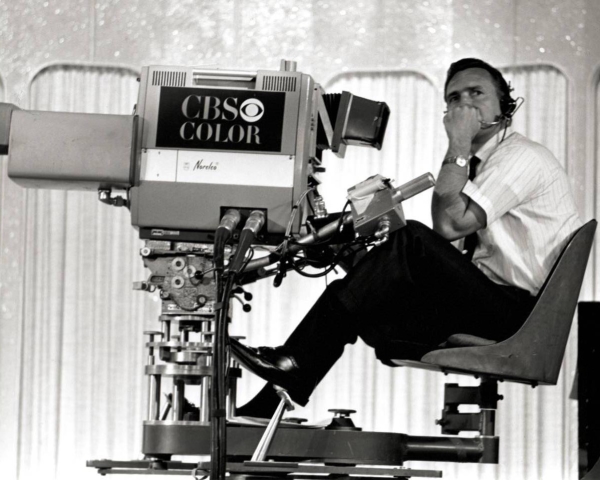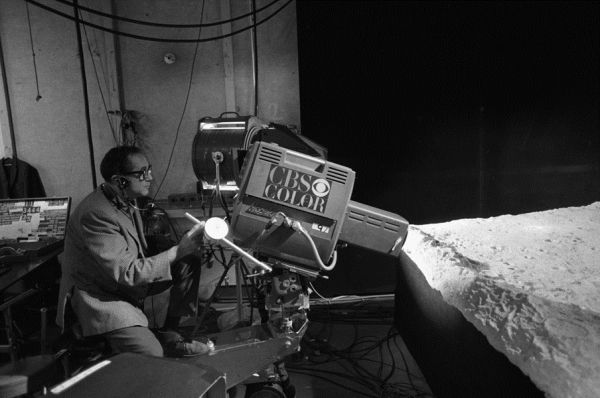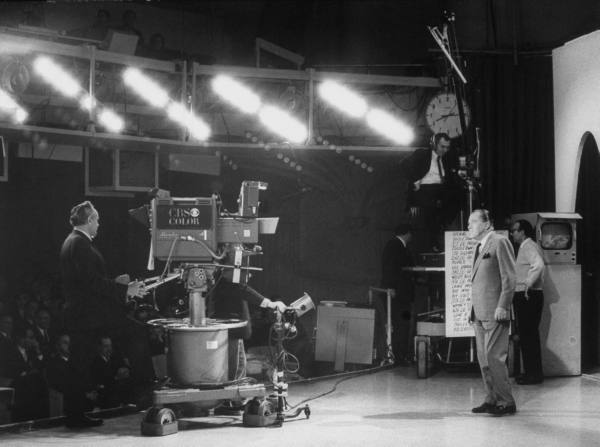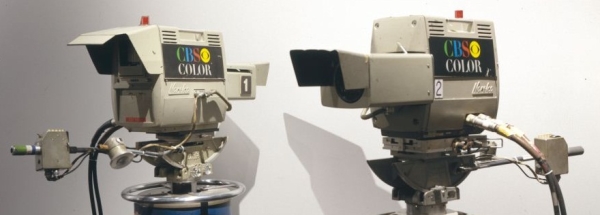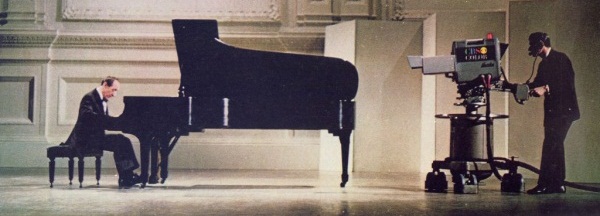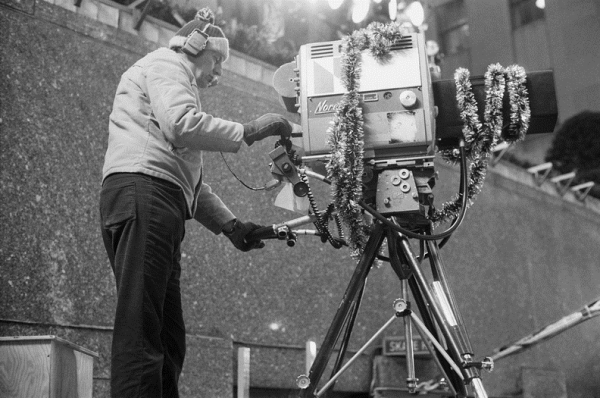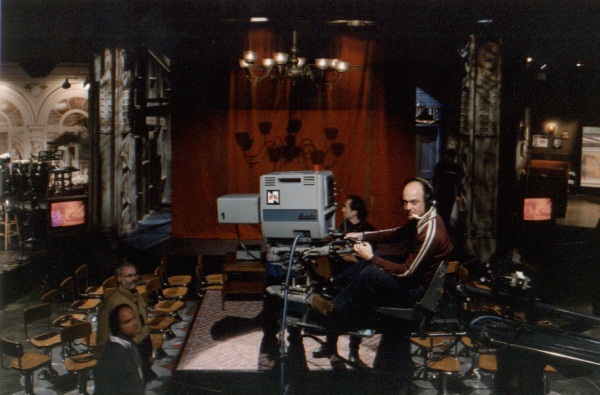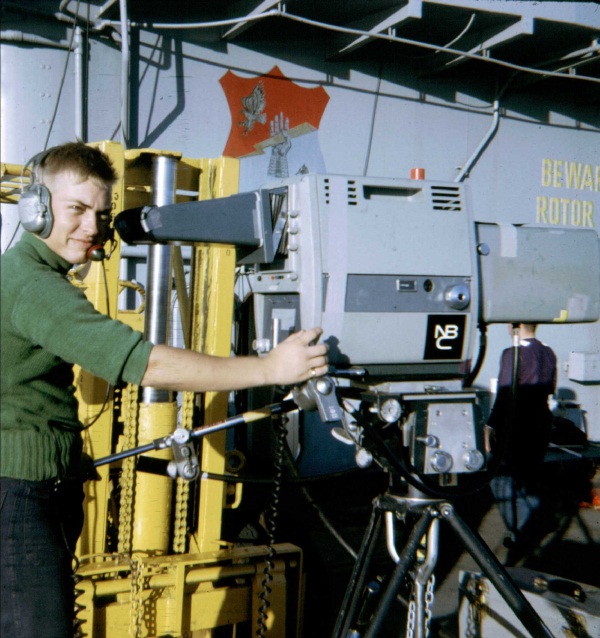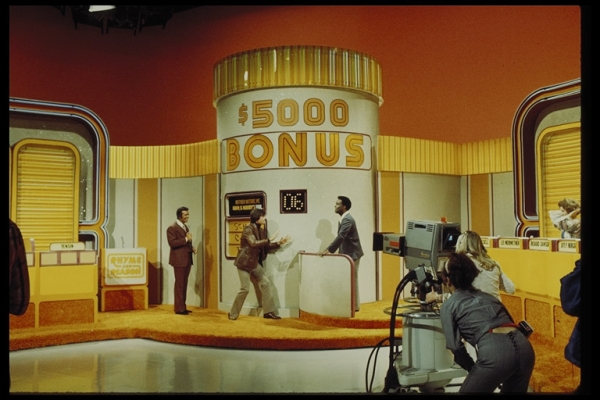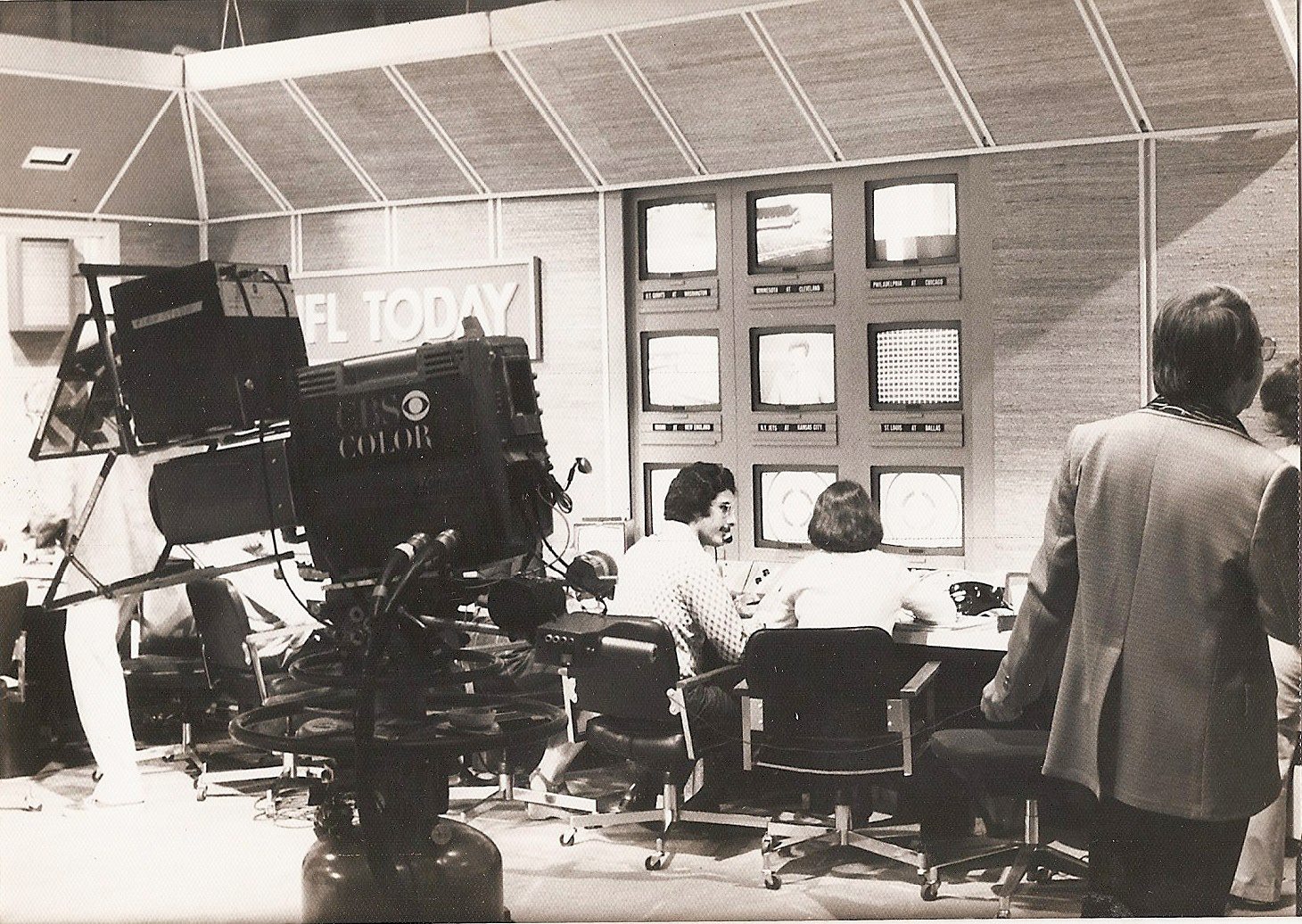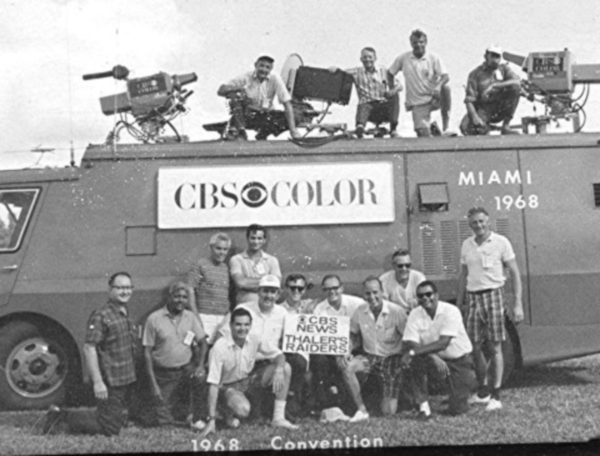Photo above is from The Ellerbee Collection, Norelco PC 60 first used at CBS Studio 52 NY, and later CBS White House Mobile Unit in Washington D.C. Photo courtesy Parker Smith
UPDATED INFORMATION: Before we get going, I want to share some new information that will help you better understand the “difference” between the Norelco PC60 and the PC70. This is from an article I wrote in November 2022.
NOW, ON TO THE HISTORY!
In the early 1960s, an experimental color broadcast camera using three of their new Plumbicon tubes, was being developed by the Philips Company in Holland. Field testing on the new camera was going on at the BBC in London, as is seen below.
1963 Philips Experimental color camera (left) at BBC, in comparison test with the Marconi BD 949
Philips 1963 experimental color television camera used for BBC tests.
Philips PC60 prototype TV camera 1964 with 5 lens turret
Philips black and white EL 8020 Plumbicon tube television camera
Using the basic design of their black and white Plumbicon equipped camera, which had been in service in Europe since 1961, the new Philips color camera was given two names…the one we know here in the US, and the one the rest of the world knows. To us, this first camera was the Norelco PC 60, but to everyone else, they were known as Philips LDK I models. Our Norelco PC 60 was their LDK I. Our PC70 was their LDK II, etc. I think LDK comes from the Dutch term for the Lead Oxide Camera…in Europe, Plumbicons are often referred to as “lead oxide valves” (valves = tubes).
The PC designation stood for Plumbicon Camera, and 60 for the year the Plumbicon was invented. Notice that the prototype pictured above has a lens turret, like the black and white cousin. With some help from the BBC, Angenieux got involved with the development, and came up with the now familiar 10x full servo zoom lens for the camera.
Where did the Norelco name come from and why? In a 1940 brand infringement lawsuit, Philco (an American electronics company), claimed the names were too similar, and was able to legally prevent Philips from using the brand name “Philips” on products marketed in the United States. Philips developed the “Norelco” brand as a portmanteau of “North American Electronics Company.” Philips got the last laugh, though, when it purchased Philco in 1981.
Although the name Philips wasn’t very familiar in the United States, the company had a huge worldwide reputation. Philips & Company started in 1891 as a manufacturer of carbon filament lamps, then branched into making radio tubes, receivers and transmitters in the 1920s. The company also conducted experiments in mechanical television late in the decade.
I’ll bet you knew about Philips’ development of the first-ever dry shaver (in the 1950s), but I’ll bet you didn’t know the audio cassette tape (1963), the first home video cassette recorder (1972), and even the compact disc (1980) were also Philips innovations.
But one particular invention is of interest to us here: the Plumbicon tube, developed by Philips in 1960. This tube, which promised true color fidelity, was manufactured by Philips subsidiary Amperex Electronics in Slaterville, Rhode Island. Philips first used the tube in a black and white camera, for durability tests, but later designed a color television camera around the new plumbicon tube, and this camera reached the market in 1964 as the PC-60. The plumbicon tube earned Philips an Emmy in 1967 for “Outstanding Achievement in Engineering Development.”
The PC-60 was followed by the PC-70, the PC-72, the portable PCP-70 and PCP-90, and in the early ’80s by the LDK series. (Later efforts included the BTS brand name, in a joint venture with Bosch, which was later sold to Thomson’s Grass Valley and became the LDK brand.)
The CBS – Norelco Connection
The PC-60 and PC-70 series were very popular cameras, and all the major networks and countless local stations used them. However, perhaps the most well-known customer was CBS, which eagerly bought Norelcos in its effort to become a color network.
Why did CBS love the Norelco cameras so much? Well, actually, there are two reasons. First, because finally a color camera was available that was not manufactured by RCA. Remember, RCA’s “compatible color” system beat out the CBS mechanical color system, and there was still a lot of resentment at CBS. The availability of a color camera that wasn’t an RCA product made it possible for CBS to hasten its transition to color, and Norelco cameras with their “CBS Color” signage became a familiar background sight on many a television program in the 1960s and 1970s.
Second, there was Dan Flaherty. In several conversations with Dr. Flaherty, he told me the story of how this all came to pass.
Dr. Daniel Flaherty was the head of CBS Engineering in the early 1960s, and had been working with Ikegami on a mini camera for CBS, to use at Cape Canaveral covering the space shots and political conventions. The BBC was also working with Ikegami on a similar project, and it was on a trip to London to see the Ikegami field tests that Dan happened to see the Philips color tests. Below is a 1962 shot of the CBS Ikegami prototype in use at McDonnell Aircraft in St. Louis during the Mercury Project era.
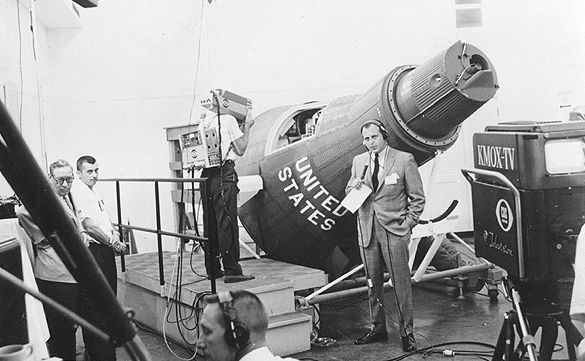
In the ’60s, the BBC was world renowned for their engineering ability and testing programs, and after he saw the Philips tests, he immediately went into action on his return to New York, to make sure CBS was first in line for these new cameras.
Even before the PC 60s were debuted at the 1964 NAB show, CBS had already placed an initial order for 36 units, and a secondary order for 36 more on an as needed basis.
As odd as it seems, NBC also bought Norelco cameras for their field trucks. NBC never used the RCA TK42 or 43, and the TK44 was very behind in it’s development. So, with an aging fleet of TK41s in the field, NBC “jumped the shark” and ordered 35 Norelcos to their unique specifications, created by NBC Labs head Fred Himelfarb.
In fact, there’s a couple of great stories about the battles at RCA/NBC over the Norelcos, the plumbicon tube, and how the TK44 came to be. Read this for the NBC story, and read to learn how Norelco inadvertently helped RCA develop its TK44. https://eyesofageneration.com/the-secret-backstory-of-the-rca-tk-44/
Image courtesy of the CBS Photo Archive. All rights reserved. This image cannot be archived, sold, leased or shared.
To me, The Smothers Brothers Comedy Hour (February 1967-April 1969) and The Carol Burnett Show (September 1967-March 1978) represent one of the greatest eras of shows ever, in the history of both CBS, and of television itself. Carol Burnett usually did her program from Television City’s Studio 33, while the Smothers Brothers did their program from Studios 31 and 41.
Notice the camera in the top photo of Tom and Dick Smothers (above), and the shot of the crane mounted camera below, on the Smothers Brothers set…the vents at the top of both PC 60 doors are vertical. This makes these, two of the original “first installs” at Television City. That means these camera were built in Holland, but production was too slow there, and Philips opened a plant in Mt. Vernon NY, to build the cameras. Notice in the Carol Burnett photo, the vents are horizontal and are PC 60s made in Mt. Vernon NY… not Holland.
If I recall correctly, Television City’s Studio 33 got the first 6 Norelcos in 1965.
Image courtesy of the CBS Photo Archive. All rights reserved. This image cannot be archived, sold, leased or shared.
Here’s Harry Belafonte on the set of The Strollin’ Twenties at CBS New York on November 30, 1965. This PC-60 is on a Chapman crane.
PC 60 in The Oval Office the night President Johnson declined to run for another term. It is possible that this camera is in my collection, (pictured at the top of this page), as it was used in the CBS Washington mobile unit, often used at The White House. Note the interesting early portable teleprompter setup.
Image courtesy of the CBS Photo Archive. All rights reserved. This image cannot be archived, sold, leased or shared.
On the set of All in the Family at Television City in 1971, Norman Lear confers with Carroll O’Connor at a dress rehearsal. Production of all the Lear shows later moved to the Metromedia Studios in LA, where all of them could be under the same roof.
Image courtesy of the CBS Photo Archive. All rights reserved. This image cannot be archived, sold, leased or shared.
Shooting the Moon! Well, virtually. Above, cameramen in Studio 41 of the CBS Broadcast Center in New York use PC-60s to shoot images of a simulated lunar surface during the flight of Apollo 11 on July 20, 1969.
Image courtesy CBS Photo Archive. All rights reserved. This image cannot be archived, sold, leased or shared.
Above, Mama Cass Elliot of The Mamas and The Papas stars in her own 1973 special at Television City. This great shot of the stage shows three of the four PC-70s on the set.
Photo courtesy Terrill Menor
Oh, those good old disco days! On the set of American Bandstand, one of the tricks the cameramen used to keep dancers from running into them was to keep some extra cable around them.
Welk’s show started locally on KTLA, then aired on ABC from 1955 to 1971. (Welk’s ABC show initially went head to head with NBC’s Your Show of Shows at 8 p.m. Saturday, and helped hasten the end of the NBC program.) Welk’s program continued on in syndication until 1982. The show’s home at ABC was Studio 55 at the Prospect lot, however, the 1965-66 (ABC’s first live color show with TK41s) and 1976-77 shows came from the Hollywood Palace, and from 1977-79 it was recorded at CBS Television City.
Photo courtesy ABC. All rights reserved. This image cannot be archived, sold, leased or shared.
Speaking of ABC and music makers, here’s Alice Cooper in a 1975 appearance on the Welk show. NOT. This is from the November 24, 1972 debut of In Concert, produced for ABC by Don Kirshner. Notice the optional Varatol lens.
Photo courtesy Mike Clark
PC-70s in action at WTVT in Tampa, on a lightweight Vinten crane. Note the Fulmar pedestal under the floor camera.
Here is the PC-70 catalogue.
Photo courtesy CBS Retirees website
For a former CBS New York cameraman, I think the photo above is the perfect image to leave behind. This distinguished looking gentleman is the late Ed Dunn.
Photo courtesy CBS Photo Archive. All rights reserved. This image cannot be archived, sold, leased or shared.
Cher checks a viewfinder shot during the taping of The Sonny and Cher Comedy Hour at CBS Television City on Jan. 20, 1972. Here you can see details of the “CBS Gray” paint job Dr. Frank Stanton ordered for all cameras as far back as the TK30s. Even though the chromed Norelco badge has been painted over, it’s still there – which is more than you can say for the logos on the RCA cameras used at CBS.
This is one of only 5 PC 71s ever built and were made with special mu-metal shielding for the insane electromagnetic problems at The Ed Sullivan Theater/CBS Studio 50. All of this was caused by a huge DC subway transformer behind the back wall of the stage.
Photo courtesy Dennis Degan
These three photos of historic cameras are presented in chronological order. The first photo, taken by Dennis Degan around 1976, show two of the four PC-60s used nightly for The CBS Evening News with Walter Cronkite in New York. Later used for Dan Rather, these cameras were retired around 1990.
CBS is proud of its tradition of donating equipment to educational, religious, and public broadcasting institutions, and these cameras were thus donated to Boston’s Catholic Broadcast Center. After a few years in use, they were taken out of service and were to be scrapped. A Boston television professional who had lovingly maintained them, and couldn’t bear to see these historic cameras thrown away, came to the rescue.
That professional was my good friend Paul Beck, a master preservationist and Curator at the Museum of Broadcast Technology. In the second photo (above), the two cameras are stored in Paul’s basement while he searched for an appropriate home for them.
The final image (above) shows them in that appropriate home: on display at the Newseum in Washington, D.C.
Vladimir Horowitz at Carnegie Hall in 1968.
Photo courtesy NBCU Photobank.com. All rights reserved. This image cannot be archived, sold, leased or shared.
Above is one of the 35 Norelco cameras NBC bought for its remote trucks. This one is dressed for the season as it broadcasts the Christmas tree lighting ceremony at Rockefeller Plaza in 1976. Note NBC’s “Nebraska N” logo on the camera.
Why is there a Norelco on the Saturday Night Live set? They were never used in the NBC studios, right? That’s correct, but this scene is a little different. This was taken during the filming of the movie Man on the Moon, starring Jim Carrey as Andy Kaufman. Here, longtime SNL cameraman John Pinto is behind a Norelco used as a prop camera during filming. (Speaking of which, you’ll love this story about the SNL Chapman Crane.)
Photo courtesy Jon Olson
And speaking of the Moon…here are two photos taken during the flight of Apollo 10 in May 1969. Not in space, of course, but in the Pacific Ocean aboard the amphibious assault ship USS Princeton, which was there to recover the astronauts at the end of their flight. NBC had pool camera duties for the live splashdown coverage of Apollo 10, and these pictures come courtesy of Jon Olson, a 30-year NBC Burbank cameraman. Above, you see one of NBC’s PC 70s. Below, cameraman Bobby Keys lugs around a Norelco PCP-70 “portable” camera. He’s smiling, but both the camera and backpack are big and cumbersome. Given the playful look on his associate’s face, and the way he’s holding that big cable head, I can almost imagine where he wanted to “plug” it in.
Photo courtesy Jon Olson
Unfortunately, Jon is not in these pictures (above) because he took them, but that’s his nature. He also took some great shots for us all with his TK 41 on The Andy Williams Show, his TK-44 on The Dean Martin Show, and much more.
Photo courtesy ABC. All rights reserved. This image cannot be archived, sold, leased or shared.
Game show action at ABC studios in Los Angeles.
Roger Mudd prepping for a weekend edition of the CBS Evening News at the Broadcast Center’s Studio 33
The NFL Today from Studio 43 in New York
Donna Quante at ABC Hollywood prepping for “Family Feud”
Turn your head and cough, please! In for a checkup at CBS NY
A CBS tech at the Broadcast Center in New York uses a pattern generator to tune up one of the network’s many Norelco cameras. Notice the zoom wheel cables go to the internal servos for the lens. The cameras are mounted on Vinten Mark III heads and TVP electric pedestals.
Photo courtesy Retired CBS Engineers
Norelcos at the 1968 Republican National Convention in Miami.
Photo courtesy Retired CBS Engineers
Here are Norelcos in use at CBS New York in 1975. This was taken during the taping of a pilot for a game show called King of The Hill, which never went into production. The host of the program was Robert Earle, who earlier had hosted The GE College Bowl on NBC. Earle was also a professor at Ithaca College in upstate New York.
Photo courtesy Dennis Degan
Above and below, some of WAGA Atlanta’s six Norelco cameras at work in 1975.
Photo courtesy Dennis Degan
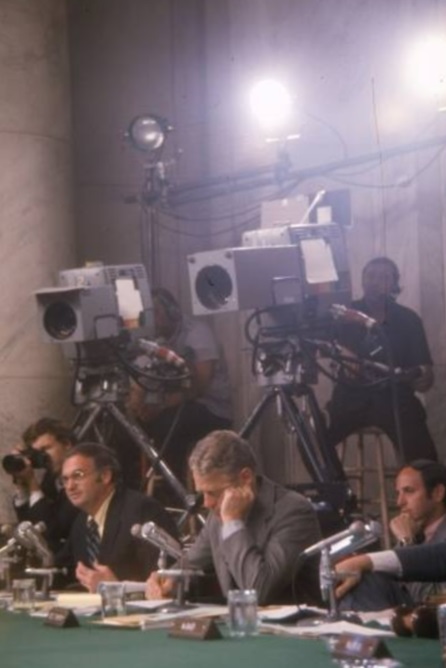
This picture from the 1973 Watergate hearings shows the optional Varatol lenses in use.




